
Sir Alexander Fleming, the discoverer of penicillin, raised the risks of antibiotic resistance in his Nobel speech. (Photograph: Peter Purdy via Getty Images)
Germ theory wasn’t always universally accepted. The now-conventional concept—the notion that human diseases can be caused by tiny pathogens that invade the body—emerged from a series of discoveries made by scientists over time. These discoveries gradually came together to create a larger picture that showed both the wonders and the horrors of the microbial world that surrounds us.
Thomas Levenson, a professor of scientific research at MIT and author, traces the evolution of germ theory from its inception to the present day in a new book, So Very Small: How Humans Discovered the Microcosmos, Defeated Germs — and May Still Lose the War Against Infectious Disease (Random House, 2025). In his book, Levenson also discusses the broader question of how and why new ideas emerge, are adopted, or are ignored.
In the following excerpt from “So Very Small,” he points out that despite our modern understanding of microbes, we are still in a constant battle with them and with our own hubris. The rise of antibiotic-resistant superbugs is a prime example of this, he says.
It is the autumn of 1945. The war in Europe has been over for five months. Something resembling normal life is beginning to return. In Stockholm, for the first time since 1938, the Nobel Foundation prepares to present its full list of prizes. The debate reaches its usual intensity as committees for each scientific discipline scramble to award no more than three people for discoveries that took dozens or more people to make. Finally, on October 25, telegrams are sent to the winners of the Nobel Prize in Physiology or Medicine: Alexander Fleming for the discovery of penicillin, and Howard Florey and Ernst Chain for transforming Fleming’s mold juice into a revolutionary medicine.
The awards ceremony will take place on December 10. The traditional after-party will feature much drinking and, rumor has it, dancing. The usually reserved Fleming will party until 3 a.m. The next day, hangovers or not, the three new laureates deliver their Nobel lectures. Fleming speaks first, spending much of his speech recounting the details of his fateful encounter with the penicillium mold. Near the end, however, he abandons the reminiscences to deliver a cautionary exhortation, urging his listeners to go forth and avoid sin:
“The time may come when penicillin will be available to everyone in the store. The risk then arises that the ignorant may underdose themselves and, by exposing their germs to insufficient amounts of the drug, make them resistant. Here is a hypothetical case. Mr. X has a sore throat. He buys some penicillin and takes not enough to kill the streptococci, but enough to teach them to resist penicillin. He then infects his wife. Mrs. X develops pneumonia and is treated with penicillin. Since the streptococci are now resistant to penicillin, the treatment is unsuccessful. Mrs. X dies. Who is primarily responsible for the death of Mrs. X? Mr. X, whose careless use of penicillin changed the nature of the germ. Moral: If you use penicillin, use enough.”
This was no mere parable. What Fleming prophesied before the great and worthy men of Sweden had already happened. The first of four cases of gonorrhea “resistant to ‘large’ amounts of penicillin” was recorded in the medical literature in 1946. Even earlier, in 1940, Edward Abraham and his colleagues in Florey’s laboratory had managed to train staph cultures to resist penicillin.
Sourse: www.livescience.com





